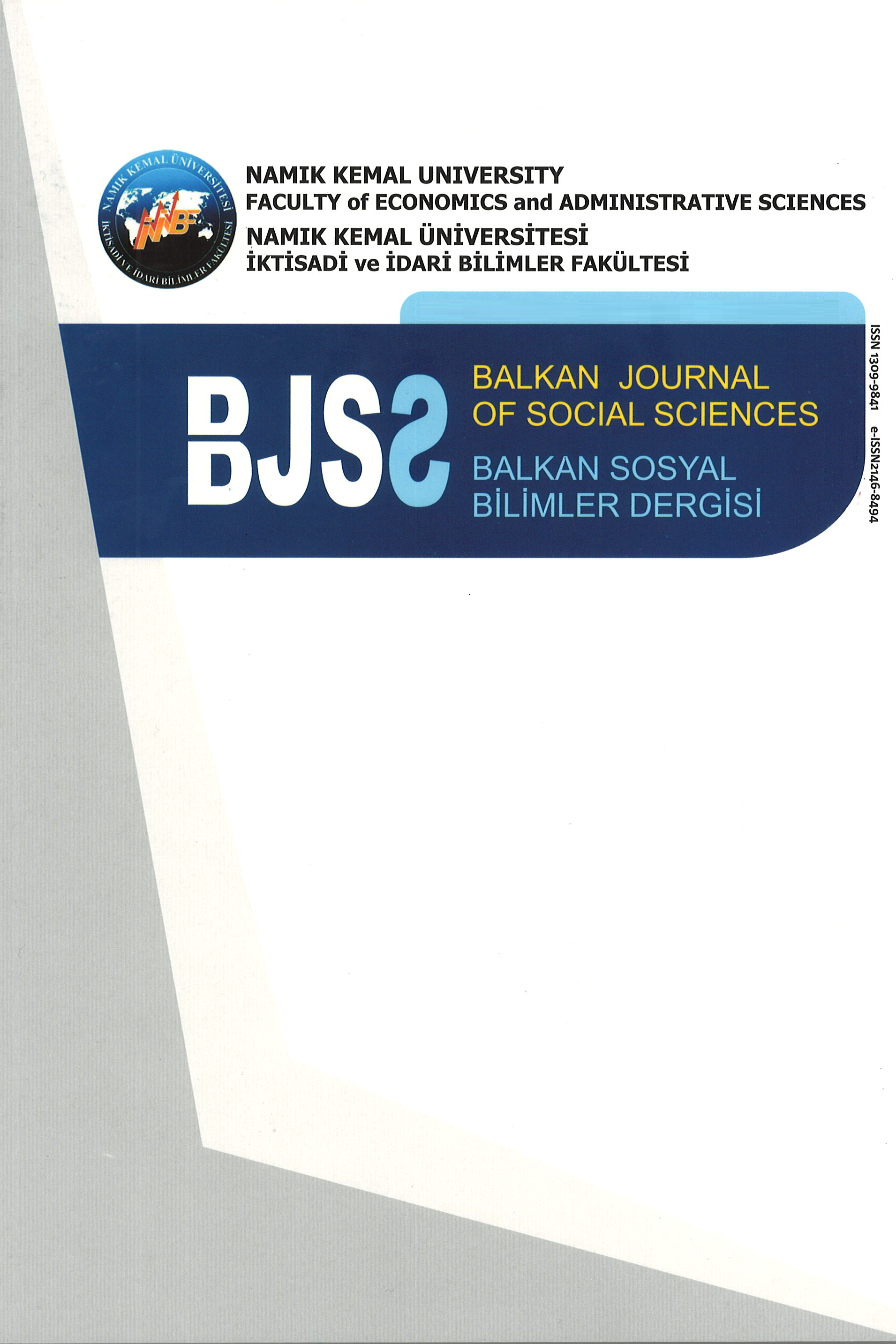PAY PİYASASI İLE DÖVİZ KURLARI ARASINDA RİSK DURUMLARINDA NEDENSELLİK İLİŞKİSİ
Pay piyasası, Döviz kurları, Nedensellik, BIST-100
___
- Abdalla, I. ve Murinde, V. (1997). Exchange Rates and Stock Price Interactions in Emerging Financial Markets: Evidence on India, Korea, Pakistan and the Philippines. Applied Financial Economics, 7, 25-35.
- Aggarwal R (1981). Exchange Rates and Stock Prices: A Study of the United States Capital Markets under Floating Exchange Rates. Akron Business and Economic Review, 12, 7–12.
- Aggarwal, R., Inclan, C. and Leal, R. (1999). Volatility in Emerging Markets. Journal of Financial and Quantitative Analysis, 34, 33–55.
- Ajayi, R.A. and Mougoue, M. (1996). On the Dynamic Relation Between Stock Prices and Exchange Rates. Journal of Financial Research, 19, 193–207.
- Bahmani-Oskooee, M. and Sohrabian, A. (1992). Stock Prices and the Effective Exchange Rate of the Dollar. Applied Economics, 24, 459–464.
- Bali, T.G. (2000). Testing the Empirical Performance of Stochastic Volatility Models of the Short Term Interest Rate. Journal of Financial and Quantitative Analysis, 35, 191-215.
- Dickey, D.A. and Fuller, W.A. (1979). Distribution of the Estimators for Autoregressive Time Series with a Unit Root. Journal of the American Statistical Association, 74, 427–431.
- Fan, Y., Zhang, Y-J, Tsai, H-T and Wei, Y-M (2008). Estimating ‘Value at Risk’ of Crude Oil Price and Its Spillover Effect Using the GED-GARCH Approach. Energy Economics, 30 (6), 1356-1371.
- Fedorova, E. and Saleem, K. (2010). Volatility Spillovers between Stock and Currency Markets: Evidence from Emerging Eastern Europe. Finance a úvěr-Czech Journal of Economics and Finance, 60(6), 519–533.
- Frankel, J. (1983). Monetary and Portfolio-Balance Models of Exchange Rate Determination. in J. Bhandari and B. Putman (Eds), Economic Interdependence and Flexible Exchange Rates, MA, MIT Press.
- Hong, Y., Li, H. and Zhao, F. (2004). Out-of-Sample Performance of Discrete-Time Short-Term Interest Models. Journal of Business and Economic Statistics, 22, 457–473. Hong, Y., Li, H. and Zhao, F. (2007). Can the Random Walk Model Be Beaten in Out-Of-Sample Density Forecasts? Evidence From Intraday Foreign Exchange Rates. Journal of Econometrics, 141, 36-776.
- Hong, Y., Liu, Y. and Wang, S. (2009). Granger Causality In Risk And Detection of Extreme Risk Spillover between Financial Markets. Journal of Econometrics, 150, 271-287.
- Kanas, A. (2000). Volatility Spillovers Between Stock Returns and Exchange Rate Changes: International Evidence. Journal of Business Finance and Accounting, 27, 447–467.
- Kim, K. (2003). Dollar Exchange Rate and Stock Price: Evidence from Multivariate Cointegration and Error Correction Model. Review of Financial Economics, 12, 301-313.
- Koseoglu, S. and Cevik, E.I. (2013). Testing for Causality in Mean and Variance between the Stock Market and the Foreign Exchange Market: An Application to the Major Central and Eastern European Countries. Czech Journal of Economics and Finance, 63 (1), 65-73.
- Kwiatkowski, D., Phillips, P.C.B., Schmidt, P. and Shin, Y. (1992). Testing the null hypothesis of stationarity against the alternative of a unit root. Journal of Econometrics, 54, 159–178.
- Liu, X., Cheng, S., Wang, S., Hong, Y. and Li, Y. (2008). An Empirical Study On Information Spillover Effects between the Chinese Copper Futures Market and Spot Market. Physica A, 387 (4), 899-914.
- Longin, F.M. (2000). From Value at Risk to Stress Testing: The Extreme Value Approach. Journal of Banking and Finance, 24, 1097–1130.
- Mansor, H.I. (2000). Cointegration and Granger causality tests of stock price and exchange rate interactions in Malaysia. ASEAN Economic Bulletin, 17, 36–47.
- Mok, H.M.K. (1993). Causality of Interest Rate, Exchange Rate and Stock Prices at Stock Market Open and Close in Hong Kong. Asia Pacific Journal of Management, 10, 123–143.
- Murinde V. and Poshakwale, S. (2004). Exchange Rate and Stock Price Interactions in European Emerging Financial Markets Before and After the Euro. Working Paper Birmingham Business School, University of Birmingham.
- Nelson, D.B. (1991). Conditional Heteroskedasticity in Asset Returns: A New Approach. Econometrica, 59, 347–370.
- Nieh, C.C. and Lee, C.F. (2001). Dynamic Relationship Between Stock Prices and Exchange Rates for G-7 Countries. Quarterly Review of Economics and Finance, 41, 477–490.
- Pan, M.S., Fok, R.C.W. and Liu, Y.A. (2007). Dynamic Linkages between Exchange Rates and Stock Prices: Evidence from East Asian markets. International Review of Economics and Finance, 16, 503–520.
- Phillips, P.C.B. and Perron, P. (1988). Testing for a Unit Root in Time Series Regression, Biometrika, 75, 335–346.
- Roberoda, J.C., Rivera-Castro, M.A. and Ugolini, A. (2016). Downside and Upside Risk Spillovers between Exchange Rates and Stock Prices. Journal of Banking and Finance, 62, 76-96.
- Roll, R. (1992). Industrial Structure and the Comparative Behavior of International Stock Markets Indices. Journal of Finance, 47, 3–41.
- Yu, Q. (1997). Stock Prices and Exchange Rates: Experience in Leading East Asian Financial Centres: Tokyo, Hong Kong and Singapore. Singapore Economic Review, 41, 47–56.
- Yayın Aralığı: Yılda 2 Sayı
- Başlangıç: 2011
- Yayıncı: Tekirdağ Namık Kemal Üniversitesi
BATI DÜNYASINDA AÇIK İSTİHBARAT AÇIK DİPLOMASİ’YE KARŞI
1973 Petrol Krizinin Ekonomiye Etkileri ve Stagflasyon Olgusu
Önder DİLEK, Uğur MİRASEDOĞLU, Kezban AYRAN CİHAN, Akif Ziya BAYRAK
REFAH DEVLETİ KAPSAMINDA NEGATİF VERGİ ve İSLAM EKONOMİSİNDE ZEKÂT MÜESSESESİ
TÜRKİYE’DE GÖNÜLSÜZ KISMİ SÜRELİ İSTİHDAMIN CİNSİYET ANALİZİ: HANE HALKI İŞGÜCÜ ANKETİNDEN BULGULAR
Ayhan GÖRMÜŞ, Çağlayan ERDOĞAN
IMF’NİN DEĞİŞİM SÜRECİ: 2008 FİNANS KRİZİ SONRASI DÖNÜŞÜM VE YENİDEN YAPILANMA*
İlhan EROĞLU, Hilal Şeker, Baki Demirel
PAY PİYASASI İLE DÖVİZ KURLARI ARASINDA RİSK DURUMLARINDA NEDENSELLİK İLİŞKİSİ
TÜRKİYE’DE ADEM-İ MERKEZİYETÇİLİK AÇISINDAN 1973 SEÇİMLERİ ÖNCESİ VE SONRASI KENTSEL SİYASETİN ÖNEMİ
ÖRGÜTSEL ÖZDEŞLEŞME ÜZERİNDE ÖRGÜTE HAKİM KURUM KÜLTÜRÜNÜN ETKİSİ
